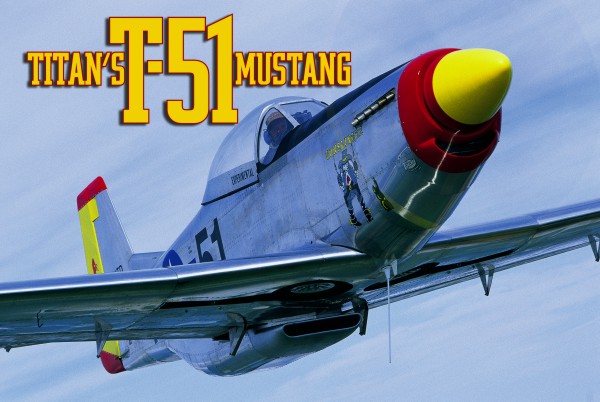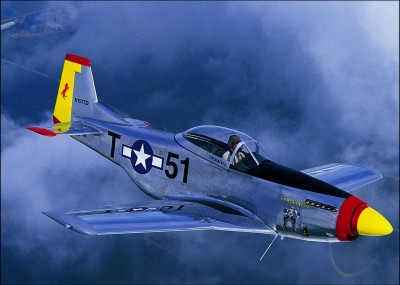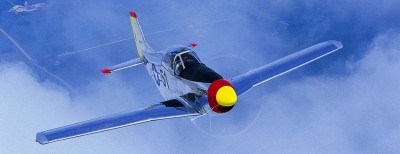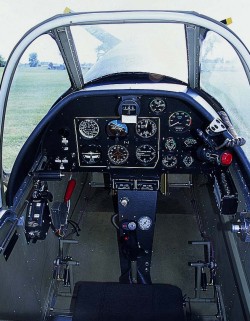



Titan Aircraft Company’s T-51 displays a commanding profile on the Ultralight/Lightplane runway down on the farm during EAA AirVenture. The 75-percent scale replica bears a striking resem-blance to its World War II namesake, the venerable P-51.

The T-51 is offered with the 100-hp Rotax 912S as the standard engine, which gives the can-tilever-winged aircraft an average cruise speed of 150 mph. The engine is located far forward in the engine compartment for weight and balance purposes.

With its “Gunslinger” nose art, the cowling and short exhaust stacks add to the P-51 look and sound|though nothing can truly replicate the sound of the Merlin engine.

The retractable landing gear is visible tucked up into the wheel wells of the T-51. Unfortunately, the gear didn’t fully lock in the down position dur-ing Dan Johnson’s flight for this report, creating an interesting, but luckily nearly harmless, end-ing to the flight.

Titan Aircraft was careful to carry the P-51 replication in the cockpit as well. Note the of-fending gear retract lever on the left-hand side of the cockpit below the throttle.


The Ending
In the remainder of this article I’ll tell you what I thought of this new offering from Titan Aircraft, the successful builder of the Tornado line of ultralights and light aircraft. But I must be forthright and tell you my hour and a quarter flight with this new airplane ended with a landing on its belly.
I rush to say it wasn’t simple forgetfulness; I didn’t forget to put the gear down. Instead, a simple mechanical problem in this prototype T-51 prevented the retractable gear from fully extending. The gear was partially down, but it refused to lock in position. A post-incident investigation revealed that a tiny activation pin broke off the gear-down microswitch when I tried to activate it with too forceful a movement. Because the micro-switch didn’t activate, the hydraulic system didn’t push the gear legs down all the way.
Considering the gear was down only about 50 percent, according to Titan President John Williams who was watching from the ground, my touch down was remarkably smooth, and the T-51 rolled for quite a few yards. However, eventually the left gear leg began to collapse followed shortly by the right, and I ended up in a belly landing that did surprisingly little damage. The prop was a goner, though.
I knew I had a problem with the gear. In fact, I was coming in for a fourth pass at landing, this time hoping that I had the gear fully down. I was initially prepared to power up and go around, so naturally I left the engine running. I’d been recycling the gear and knew it was moving up and down. But the T-51 never showed me those re assuring three green lights that would tell me the gear was down and locked.
I was running out of options and wanted to try to feel the wheels touch. Maybe they actually were extended, I hoped. When I first felt the wheels rolling I yielded to a microsecond of relief. “They are down,” I thought! Unfortunately, by the time I faced reality that this was unlikely without green lights, I’d already waited too long to fire up the engine and go around again.
It really didn’t matter. I was about out of daylight, and I was flat out of ideas. And going around one more time wouldn’t have produced a different resolution. But I was quite fortunate. The rather smooth ending of this flight was a function of the aircraft’s slow touchdown speed and gentle rate of descent-remember, I was “feeling” for the ground-combined with a softer turf runway and the wheels rolling for a fair distance before folding up.
Though this “discovery flight” alarmed everyone-including a couple of government observers who never mentioned their jobs (another story)-I wasn’t hurt in the least. After some minor sheet metal repair, a new prop, a fixed gear lever, and a thorough inspection of the whole airframe, the T-51 was back in the air.
Twenty Minutes Earlier
After three-quarters of an hour flying around in this exciting machine-most of which I found quite enjoyable-I headed back to my departure airport for a series of takeoffs and landings. This is a common practice for me-doing touchdowns and re-launches after I learn a few things about how an airplane handles.
The day was a typically steamy April afternoon in central Florida. I was warm anyway; ventilation in the T-51 prototype leaves a lot to be desired in hot climates. For some of the flight, and unknown to me, I had the gear partly down when I thought I had it up. (The T-51 has no gear-up lights.) Though it sounds counterintuitive, John said the T-51 ventilates better with the gear up, so unknowingly I’d been redirecting some engine heat into the cabin. Combined with the sultry day, I was sweating up a storm in the cockpit|and I didn’t even know I was in trouble yet.
After factoring in some other air traffic in the area, I approached the pattern and swiveled the gear lever forward to the gear-down position. I felt the hydraulics work, but the green lights that would indicate the gear was locked in position never lit up. Hmm?
I exited the pattern before getting in the way of other traffic so I’d have time to solve this dilemma. Again, I tried the gear lever. I felt movement up and down but got no lights. At this point I think I slammed that lever harder, hoping to activate the switch. The micro-switch’s activation pin may have already been broken at this point, but I kept trying. I put the gear in the down position and tried yawing back and forth hoping to persuade the gear leg to lock down. I got it down about 80 percent that time, John later recounted to me, but it still didn’t show the green light. I’d done this air pressure trick at the pattern speed I’d been flying when the problem arose. I never thought to speed up to accentuate the movement.
I tried to radio my predicament and ask for advice, but I heard nothing but static. (I’ll explain that problem later.)
With daylight waning, I decided to fly over the runway in an obvious pass and see if any of the observers there signaled anything. If the green lights had burned out and the gear was actually down, no one would do anything, I reasoned. But if they saw me about to land with the gear up, surely someone watching would wave me off. Someone did.
I saw a figure run to the strip and wave vigorously. I assumed that meant they saw an unsafe condition so I went around, again trying the gear lever, cycling up and down, hoping for three green. I never saw them. After running through all my options, at last I tried the soft touchdown described above, and the end is now the beginning of the story.
If I’d been as familiar with this prototype T-51 as developer John Williams is, I might have tried another trick or two. One John suggested later was to get the airplane very sideways at some speed and use air pressure to kick the gear into a fully locked position. I had tried this, but not at high enough speed to do the job-John says it takes 120-140 mph to do this from the half-down position I experienced. I should also have allowed more time, as the hydraulic system moves slowly without the boost motor running (see sidebar for more detail).
Since this incident, Titan Aircraft has made two refinements that should save others from my experience. First, John redesigned the gear lever arm so it cannot hit the switch activator sideways (which is why it broke off when I slammed it into its notch). Secondly, he added a dump valve to bleed off pressure. After using this valve the gear would be allowed to fall most of the way down, after which you’d need modest air pressure to reach the over-center position.
In later discussions, John said my experience was an interesting study. No one would have voluntarily done a gear-up landing (or at least a gear-not-fully-down landing), but now the company knows that a skidding stop may be the worst of it. Of course, this “study” isn’t comprehensive and doesn’t assure another pilot will have the same non-threatening experience, but it is some information that the Titan designers did not have before I came to an ungraceful stop.
I will admit to some mistakes in this flight. First, I should have been more certain of the radio operation. The T-51 had a radio installed, but I failed to raise anyone on it because, it turns out, I was pushing the wrong transmit button. The correct one is on the throttle, not the joystick, to exactly imitate the original P-51. I didn’t have the radio on when I left the airport, and we hadn’t agreed to a frequency. Had I used the right transmit button and made contact with the folks at the airport, John might have explained the higher speed skidding that could’ve thrown the gear legs out.
Secondly, though clearly done for rational reasons, John chose not to accompany me on this flight, though a second seat (without controls) is available. The prototype T-51 is about 100 pounds heavier than the production kit version will be, and John didn’t want to overload the machine on a hot day. His counsel aloft would’ve been useful, but I understand his decision.
Third, especially because the T-51 is a more complex aircraft, I should have flown it earlier in the day. My effort to fit in two or three airplane review flights that day put pressure on me to work longer hours than might be advised. Running out of daylight is no smarter than running out of fuel, and I should have known better. Okay, enough confessions of a test pilot. Let’s look at all the other aspects of Titan’s exciting new kit.
An Hour and a Half Earlier
John described the T-51 as being a pussycat to fly. He also said that it was easy to ground handle despite it being a taildragger. In both of those forecasts, he was right on the money. The T-51 is an easy aircraft to fly. It does slow down well. I saw stalls at 40 mph, and at that speed, the T-51 was not a handful to operate.
After flying two other ultralights that afternoon, I finally got my chance at the T-51 Mustang, the first reporter to get the honor. John had chosen to wait a year before letting me go because his team was still working out details. They had plenty of them.
The T-51 is a much more involved aircraft than most light sport planes. I’m FAA certificated for complex aircraft with retractable gear and constant-speed props, plus I have a twin-engine rating. Flying any such aircraft requires familiarization. John and I reviewed the T-51’s interior for nearly 45 minutes before I flew. Most ultralights take just a few minutes.
The T-51 I flew was a prototype. Production kits will see improvements in several areas, and the gear lever system is one of them. The new hardware will not allow a forcefully thrown lever to damage the microswitch.
Nonetheless, I see merit to keeping things simple. The T-51 is quite complicated for many sport pilots. I compare it to a Beechcraft Bonanza I flew for many hours. That “H” model came with six fuel tanks (including the optional tip tanks), and the pilot had to manage fuel flow every 30 minutes. It was too much pilot workload and invited errors.
An Hour and a Quarter Earlier
John said that the T-51 was easy to ground handle despite it being a taildragger. This proved correct.
Though the effort of steering the T-51 was easier than expected, you still cannot see forward well, so a fishtailing taxi is involved. Having to sway back and forth demands that you keep a slow speed en route to the end of the runway, but the tailwheel and pedals work together to make such maneuvering easy.
The T-51’s canopy is a chain-driven, hand-cranked affair that also requires you to lock some small aluminum latches to assure the canopy stays closed. I thought I had these nailed down, but on initial acceleration the right latch flipped out of position. I aborted the takeoff and taxied back to tighten the latches. After taking care to be sure these tiny latches were secured, my subsequent takeoff went undisturbed by the canopy.
Ventilation is an interesting aspect of the T-51. John told me that the T-51 vents engine heat through the landing gear door openings, but counter-intuitively, the venting occurs best with the gear in the up position. Because I lacked experience with the gear operation system, I purposefully had the wheels down throughout much of the flight. Because the venting of heat is not as effective with the gear down, and because the Florida day was already very warm, I was hot inside the T-51.
Not only was I sweating the gear problem I faced as the sun was setting, but also the ventilation issues made my perspiration run on overdrive. Surely, this didn’t help my problem-solving ability. I was quite uncomfortable. The T-51 needs some air inlets badly. Of course, any builder could do something about this problem, and flying in a cooler climate might never introduce the problem. Please remember that this T-51 is the prototype, and production versions can cure such problems.
Visibility out of the aircraft is quite good, but the windshield is built like an authentic P-51, and looking out the front comes with structural obstructions. It made me think about those World War II fighter pilots trying to spot enemy aircraft, and I concluded that it must have been quite a challenge, even for 20-year-old, highly motivated eyes.
The T-51 flaps operate nicely. They go down quickly, and the position indicators on the flap itself are easily deciphered.
Keeping up with the prop control, trying to keep it under 5800 rpm, yet maintaining high enough revolutions so the engine could provide adequate power proved to be a time-consuming task. John had advised me of this, and I dealt with it adequately, but a constant-speed prop would certainly be better.
An Hour Earlier
After the canopy opening on my first takeoff, my subsequent takeoff went smoothly, and the T-51 takes to the air like a natural. Though it looks uncannily like the full-sized P-51 Mustang, it flies easily enough for most sport pilots with experience in systems management.
I didn’t see the higher speeds I expected since I was inadvertently flying around a lot of the time with the gear partly down. John had indicated the T-51 will cruise at 150 mph or better with the Rotax 912S engine and its 100 hp. Based on my experience with the plane, I don’t doubt this fact. And now, Titan has nearly completed installation of a Rotax 914 turbo. Yee haa!
The T-51’s handling was very acceptable to me. John had told me it was very light in handling. You aren’t given much feedback. But it was not lighter than a Kitfox, for one example, and it was not as twitchy as some shortcoupled designs. All T-51 handling can be described as stable though responsive.
Steep banked turns were easy to execute. Though I didn’t try any barrel rolls, I can see how the T-51 would do them as John indicated.
Of course, I did do the Dutch rolls that have become an essential part of all my aircraft evaluations. These non-aerobatic coordination exercises were easily done to fairly steep angles, a good sign of cooperative handling.
The T-51 has rudder and elevator trim for in-flight adjustments. I didn’t notice a great deal of action when I articulated the elevator trim, and the rudder trim was inoperative on this prototype. It had been removed, though Titan will offer rudder trim as an option. I generally found that trim was hardly needed except, as John says, at altitude cruising when you wish to sustain airspeeds and altitudes in a narrow range.
John indicated the T-51 tends to wander somewhat when looking at a sectional map. I didn’t find this quality in my hour and a quarter flight, but when I kept fiddling with the gear control lever, I found the T-51 doesn’t maintain its flight attitude well; you must fly the airplane. For a sport plane, this is a pleasure. It is less desirable for a cross-country cruiser, and therefore, I didn’t find great value to the high cruising speeds Titan reports.
Stalls were very mild in the T-51 prototype. I never set the power below 4000 rpm as a vibration occurred at lower settings. Neither did I do full power stalls since the aircraft was a prototype, and I wasn’t doing experimental test pilot work.
I performed mostly slow-cruise power stalls, but I did several and never found evil tendencies. I saw stalls at 40 mph indicated, and the T-51 behaved itself very well during these trials. Titan quotes stall at 39 mph.
Thirty Minutes Earlier
Normally, I spend a fair amount of my evaluation time doing takeoffs and landings. It’s an excellent way to feel out an airplane, and it’s an essential skill. Pilots looking to buy an aircraft always want to know something about takeoff and landing characteristics.
In the T-51 Mustang, I made several approaches, but only two touchdowns, and it isn’t fair to call one of them a “touchdown.” Perhaps “crunchdown” would be more appropriate.
Though my final landing wasn’t as pretty as anyone would have liked, I did have one successful landing. As I rolled out on my first takeoff the canopy slid open an inch or two. John had told me not to have the canopy open in flight, so I aborted the takeoff after rising only a few feet into the air. My subsequent touchdown was good despite my distraction with the canopy and operating a new, complex aircraft for the first time| solo. Afterward, I gained additional experience with taxiing after landing well down the runway and having to return to the opposite end.
John told me to wheel land the T-51 and not try a three-point landing, which is always my preference on taildraggers. Part of the reason for his advice is to assure you can see over the nose. On a normal, nose-high, three-point landing, your forward visibility might be impaired.
I remember that on my first aborted takeoff, the nose did yaw significantly, and I could sense the anxiety of a couple fellows watching from the side. I easily regained control, but a first takeoff in the present version of the T-51 has a lot going on for the pilot to monitor.
And Now?
The entire layout of the T-51-the obvious external comparison to the original Mustang but also the interior-looked very military. If you are drawn to such nostalgia aircraft, the T-51 preserves the imagery better than, say, the Loehle 5151 Mustang, which carries the exterior look but lacks the same definition on the inside.
Titan’s T-51 kit has an estimated build time of 600 hours-which surprisingly low and is a credit to the hard work of Titan’s design team. The kit includes all required materials, components, and fasteners but does not include the engine, propeller, and instruments because of different customer preferences.
Titan says, “When equipped with the Rotax 912S engine, controllable propeller, and a full complement of necessary flight instruments, we expect the finished T-51 to cost well under $50,000.” The basic kit lists for $36,000.
With an airplane kit of this type, you’ll want to spend some time talking to factory experts. And you need to be honest about your ability not just to build the plane, but also to fly it when done. It isn’t hard to fly, but it will take much more concentration than most ultralights or light-sport aircraft, the rule under which Titan hopes to sell the all-metal bird. [Editor’s Note: The notice of proposed rulemaking (NPRM) for light-sport aircraft specified that the aircraft would be limited to fixed-gear aircraft, or repositionable in the case of amphibians. Whether the final rule will offer changes to that specification remains to be seen. If left as proposed, the T-51 may only meet the light-sport aircraft criteria as a fixed-gear aircraft.]
The T-51 Mustang definitely has the gung-ho fighter aircraft look and feel, but it’s not difficult to handle. Though you absolutely need some good experience to deal with the T-51’s complexities, it won’t require a long learning curve to fly it. Contrarily, you have much more systems management to do, and you cannot take flying the T-51 casually. It is definitely not a beginner aircraft, but it will be an ideal move-up candidate for pilots with a good many hours logged.
With its dashing flight traits and its adherence to World War II authenticity, the T-51 is going to make a number of buyers very happy and very proud. When you land a T-51 at an airport that hasn’t seen one, allow extra time for fascinated airplane buffs to look it over thoroughly.
| Seating | 2, tandem 1 |
| Empty weight | 750 pounds |
| Gross weight | 1,232 pounds |
| Wingspan | 24 feet |
| Wing area | 118 square feet |
| Wing loading | 10.4 pounds/square foot |
| Length | 23.5 feet |
| Height | 9.2 feet |
| Fuel Capacity | 23 gallons |
| Kit type | Assembly Kit |
| Build time | 600 Hours |
| Notes: | 1 No controls in rear seat |
| Standard engine | Rotax 912S |
| Power | 100 hp |
| Power loading | 12.3 pounds/hp |
| Cruise speed | 150 mph |
| Stall Speed | 39 mph |
| Never exceed speed | 197 mph |
| Rate of climb at gross | 1,200 fpm |
| Service Ceiling | 16.000 feet (est.) |
| Takeoff distance at gross | 300 feet |
| Landing distance at gross | 300 feet |
| Range (powered) | 720 miles (5 hours) |
| Fuel Consumption | 4.0 gph |


Leave a Reply